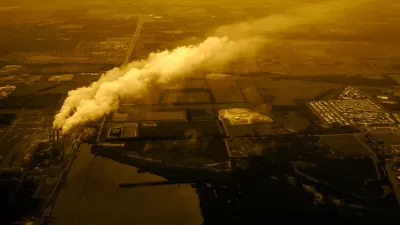Construction began July 16 on the Petra Nova project, 27 miles from Houston. President Obama and many climate experts are banking on CCS to mitigate carbon emissions from the world's largest source of carbon emissions: coal burning power plants.
Coal burning power plants remain the greatest source of emissions in the U.S. and worldwide, and coal usage is on the rise globally, notwithstanding it being the most polluting of fossil fuels. Carbon capture and storage (or sequestration) is a key strategy in the president's climate initiative, particularly as it applies to new power plants, though much skepticism has been expressed about it.
"The widespread deployment of carbon capture and sequestration (CCS) technology is viewed as essential to stopping runaway climate change, but the high price of CCS projects coupled with the lack of a national carbon price have made it difficult for power companies to justify the investment," writes Rory Carroll for Reuters.
When completed in 2016, the Petra Nova Carbon Capture Project will trap 1.6 million tons of carbon annually from one unit of NRG's WA Parish power plant and pipe it 82 miles (132 km) to the West Ranch Oil Field.
That would a 90 percent capture rate of the CO2 emitted from that unit according to the Department of Energy press release.
The $1 billion project is being constructed by NRG Energy and Japan's JX Nippon with the help of a $167 million grant from the U.S Department of Energy. "Selling carbon dioxide and increasing oil production are ways for the two project owners to recoup the cost of building the project," writes Forbes contributor Ucilia Wang.
Carbon dioxide will be utilized by oil companies in a process called enhanced oil recovery (EOR) using gas injection whereby the carbon dioxide is injected into the oil wells to release otherwise hard to recover oil.
"First employed in the US in the early 1970s in Texas, CO2-EOR is successfully used in Texas and New Mexico and is expected to become more widely spread in the future. Nearly half of the EOR employed in the US is a form of gas injection," according to the oil and gas website, Rigzone. However, oil companies have been relying on naturally occurring carbon dioxide underground reservoirs for the procedure.
"Oil production at the field is expected to rise from 500 barrels per day to more than 15,000 barrels per day [32%] as a result," writes Carroll.
The carbon dioxide injected into the ground in the EOR process remains trapped, writes Emily Guerin of High Country News, though there are fears it will escape.
The carbon dioxide injected into the ground remains trapped, writes Emily Guerin of High Country News, though there are fears it will escape.
One such doubter is Greenpeace, writes StateImpact reporter Dave Fehling in an article about the project when proposed in 2012.
“Anybody who’s independent enough and really worth their salt is never going to guarantee you that you can store this highly pressurized (CO2) underground for thousands of years and expect it to stay there,” said Ryan Rittenhouse with the environmental group Greenpeace. It’s backing a protest organization called Quit Coal.
The importance of CCR to the coal-power electricity generating plants can not be overstated.
"We are building a model that is a win-win for both industries, providing the CO2 that the oil industries needs [sic] and the revenue the generating companies need to make projects like this economic," said Arun Banskota, president of Petra Nova project.
It's more or a triple win when you consider the president's climate initiative.
"As part of the President’s all-of-the-above approach to American energy, the Department is advancing the technologies that will help ensure we can continue to develop all of our abundant energy resources responsibly and sustainably," said Secretary Ernest Moniz in the National Energy Technology Laboratory (NETL), Department of Energy press release of July 16.
"With coal expected to remain a significant part of the energy portfolio in the U.S. and internationally, first-of-a-kind projects like Petra Nova will move us toward a low-carbon energy future," Moniz said.
Wang provides an excellent take-away for this post: "Carbon capture still has a way to go to be considered a financially viable option. NRG’s project will be a good test case to show whether the technology will play a significant role in reducing pollution and the impact of climate change."
FULL STORY: Texas carbon capture venture aims to boost oil production

Alabama: Trump Terminates Settlements for Black Communities Harmed By Raw Sewage
Trump deemed the landmark civil rights agreement “illegal DEI and environmental justice policy.”

Study: Maui’s Plan to Convert Vacation Rentals to Long-Term Housing Could Cause Nearly $1 Billion Economic Loss
The plan would reduce visitor accommodation by 25% resulting in 1,900 jobs lost.

Planetizen Federal Action Tracker
A weekly monitor of how Trump’s orders and actions are impacting planners and planning in America.

Wind Energy on the Rise Despite Federal Policy Reversal
The Trump administration is revoking federal support for renewable energy, but demand for new projects continues unabated.

Passengers Flock to Caltrain After Electrification
The new electric trains are running faster and more reliably, leading to strong ridership growth on the Bay Area rail system.

Texas Churches Rally Behind ‘Yes in God’s Back Yard’ Legislation
Religious leaders want the state to reduce zoning regulations to streamline leasing church-owned land to housing developers.
Urban Design for Planners 1: Software Tools
This six-course series explores essential urban design concepts using open source software and equips planners with the tools they need to participate fully in the urban design process.
Planning for Universal Design
Learn the tools for implementing Universal Design in planning regulations.
Caltrans
Smith Gee Studio
Institute for Housing and Urban Development Studies (IHS)
City of Grandview
Harvard GSD Executive Education
Toledo-Lucas County Plan Commissions
Salt Lake City
NYU Wagner Graduate School of Public Service



























